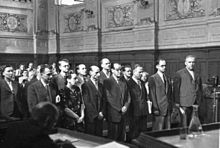Nagode Trial

The Nagode Trial (Slovene: Nagodetov proces) was a political show trial in Slovenia, Yugoslavia in 1947.[1]
The trial was carried out by the Slovene authorities under the leadership of the Communist Party of Slovenia against non-communist politicians that wished to participate in politics in Slovenia after 1945. In May 1947 the State Security Administration (i.e., the secret police, UDBA) arrested 32 highly educated intellectuals. These included some former members of the Communist Party of Slovenia, but the majority were liberal democrats that were inclined toward western-style parliamentary democracy. On 27 July 1947, the indictment was brought against 14 accused. Those were Črtomir Nagode, Ljubo Sirc, Leon Kavčnik, Boris Furlan, Zoran Hribar, Angela Vode, Metod Kumelj, Pavla Hočevar, Svatopluk Zupan, Bogdan Stare, Metod Pirc, Vid Lajovic, Franjo Sirc, and Elizabeta Hribar.[2] Proceedings against Franc Snoj were added to this trial on 4 August.[3][1] They were interrogated and tortured for two months in Ljubljana's prisons. The Politburo of the Central Committee of the Communist Party of Slovenia used the Yugoslav media to characterize those arrested as "a handful of spies, class enemies, foreign paid agents, who have no political program and whose work, with no political value at all, is to damage the people's authority." The trial against the accused began on July 29,[4] and the proceedings were broadcast to the public via special loudspeakers on the streets. The public prosecutor in the trial was Viktor Avbelj,[1] later a president of the presidency of the Socialist Republic of Slovenia,[5] and Drago Supančič was used as an incriminating witness.[6] The trial became known as the "Nagode trial" after the principal defendant. After 13 days of hearings, on August 12 three of the defendants (Nagode, Boris Furlan, and Ljubo Sirc) were sentenced to be shot,[1] and the remainder were sentenced to lengthy prison sentences with forced labor, deprivation of all civil rights, and confiscation of their property.[7][1] Nagode was shot on August 27, 1947[8][Note 1] and the death sentences against Furlan and Sirc were commuted to 20 years in prison.[1] Two of those sentenced committed suicide.
In 1991 the Supreme Court of the Republic of Slovenia overturned the conviction against Nagode and his fourteen co-defendants[1] on the grounds that it was based on false testimony and that it had been a corrupt trial against imaginary Western spies.
Notes and references
[edit]Notes
[edit]- ^ The inscription on the Nagode family gravestone in Žale cemetery has the death date 27 August 1947, also agreeing with the date of his mother's suicide, but Boris Mlakar's article states 12 September 1947.[8] Another source gives the date as 8 September 1947.[9] The plaque on the Nagode house states that he was executed in August.
References
[edit]- ^ a b c d e f g Vodušek Starič, Jerca. 1993. Nagodetov proces. Enciklopedija Slovenije, vol. 7, p. 270. Ljubljana: Mladinska knjiga.
- ^ "Пред Врховним судом Наредне Републике Словеније почиње у уторак 29. јула претрес против четрнаесторице интелектуалаца због злочина противу народа". Borba (in Serbian). 12 (178): 8. 28 July 1947.
- ^ "Врховни суд Словеније прихватио је предлог јавног тужиоца да покрене кривични поступак против Франца Сноја". Borba (in Serbian). 12 (185): 5. 5 August 1947.
- ^ "У Љубљани је почело суђење четрнаесторици припадника противнародне организације на челу са Борисом Фурланом". Borba (in Serbian). 12 (180): 6. 30 July 1947.
- ^ Sirc, Ljubo Sirc. 2010. Dolgo življenje po smrtni obsodbi.Ljubljana: Nova obzorja.
- ^ Vode, Angela, & Alenka Puhar. 2004. Skriti spomin. Ljubljana: Nova revija, p. 84.
- ^ "Чртомир Нагода, Љубо Сирц и Борис Фурлан осуђени су на смрт стрељањем, а остали на временске казне". Borba (in Serbian). 12 (192): 5. 13 August 1947.
- ^ a b Mlakar, Boris. 1993. Črtomir Nagode. Enciklopedija Slovenije, vol. 7, p. 270. Ljubljana: Mladinska knjiga.
- ^ Kurnjek, Branko, Marjan Maučec, & Iztok Mozetič. 1999. Dnevno časopisje o duhovniških procesih na Slovenskem 1945–1953. Ljubljana: Inštitut za zgodovino Cerkve pri Teološki fakulteti Univerze v Ljubljani, p. 128, fn. 147.
